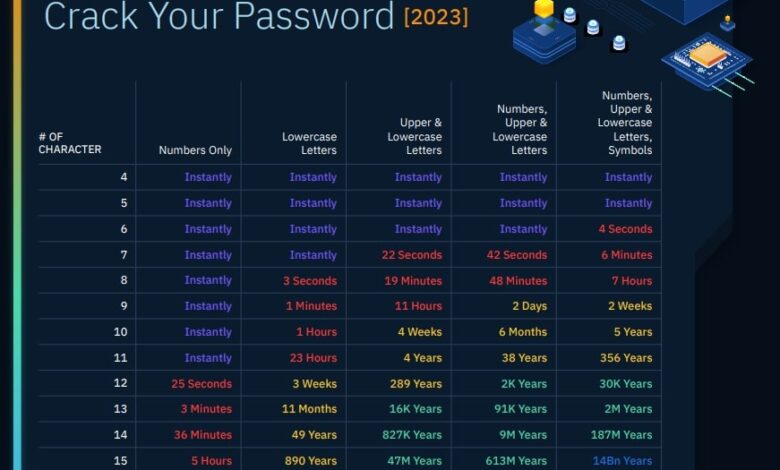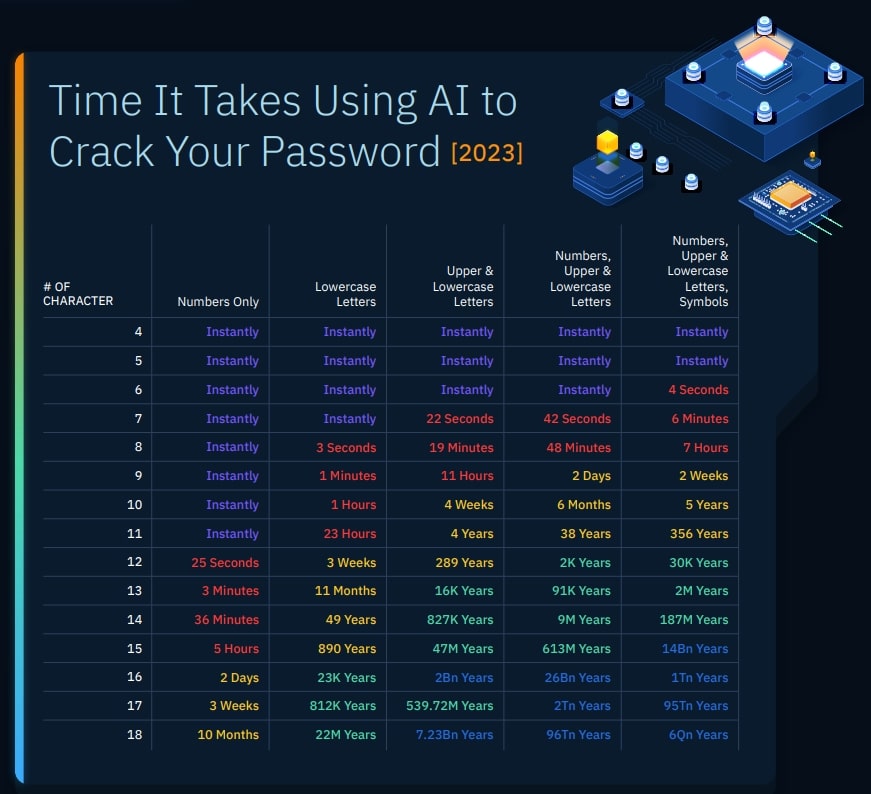
AI-Powered Password Theft A Growing Threat
Exploitation of artificial intelligence AI technology to facilitate password theft is no longer a futuristic fear; it’s a present-day reality. Malicious actors are leveraging the power of AI to automate attacks, personalize phishing campaigns, and bypass traditional security measures with frightening efficiency. This isn’t just about brute-force cracking anymore; AI is allowing for sophisticated, targeted attacks that exploit human psychology and technological vulnerabilities in unprecedented ways.
We’re entering a new era of cybersecurity threats, and understanding how AI is being weaponized is crucial to staying safe.
From AI-powered malware that self-evolves to evade detection to deepfakes that manipulate trust, the landscape is constantly shifting. This post will explore the various methods used by cybercriminals, examining the role of AI in everything from credential stuffing to social engineering. We’ll also delve into how AI is being used defensively to strengthen password security and develop more robust systems.
Methods of AI-Facilitated Password Theft
The rise of artificial intelligence has unfortunately opened new avenues for malicious actors seeking to compromise online security. AI’s ability to process vast amounts of data and learn from patterns makes it a powerful tool for password cracking, significantly surpassing the capabilities of traditional methods. This section explores the specific techniques used to leverage AI for password theft.
AI-powered password cracking isn’t just about brute-forcing passwords faster; it’s about intelligently targeting weaknesses and automating the entire process. This leads to a higher success rate and a lower barrier to entry for cybercriminals.
AI-Enhanced Brute-Force Attacks
AI significantly accelerates brute-force attacks by optimizing the guessing process. Traditional brute-force methods try every possible combination randomly. AI algorithms, however, can learn from previous attempts, adapting their strategies to prioritize more likely password combinations. This includes leveraging machine learning models to predict common password patterns and structures, thereby drastically reducing the time needed to crack a password. For example, an AI might learn that passwords often contain a combination of uppercase and lowercase letters, numbers, and symbols, and it would prioritize trying those combinations first.
This targeted approach makes brute-force attacks exponentially more effective.
Machine Learning for Pattern Recognition in Passwords
Machine learning plays a crucial role in identifying common password patterns and weaknesses. AI models can be trained on massive datasets of leaked passwords to identify frequently used sequences, common substitutions (like replacing ‘i’ with ‘1’ or ‘o’ with ‘0’), and predictable structures. This allows attackers to create more effective wordlists for dictionary attacks or to intelligently guide brute-force attempts.
For instance, an AI could recognize that a significant portion of passwords use easily guessable words or names combined with simple numerical sequences.
AI-Driven Dictionary Attacks
AI can enhance dictionary attacks by generating highly effective wordlists. Traditional dictionary attacks rely on pre-compiled lists of common words and phrases. AI, however, can generate far more extensive and sophisticated wordlists by combining words, adding variations (like capitalization and special characters), and incorporating information gleaned from social media profiles or other publicly available data. This increases the chances of guessing passwords that deviate from standard dictionary entries.
For example, an AI could combine a user’s name with their pet’s name and common birthdates to create highly targeted password guesses.
Table of AI-Facilitated Password Theft Methods
| Method Name | Description | Effectiveness | Mitigation Strategies |
|---|---|---|---|
| AI-Enhanced Brute-Force | AI optimizes brute-force by learning from previous attempts and prioritizing likely combinations. | High, significantly faster than traditional brute-force. | Use strong, complex passwords; implement rate limiting; utilize multi-factor authentication. |
| Machine Learning Pattern Recognition | AI identifies common password patterns and weaknesses from leaked data to guide attacks. | High, allows for targeted attacks on vulnerable passwords. | Use password managers; enforce password complexity rules; regularly update passwords. |
| AI-Driven Dictionary Attacks | AI generates highly effective wordlists by combining words and adding variations. | Medium to High, depending on the sophistication of the AI and the target passwords. | Avoid easily guessable words and phrases; use password managers; regularly update passwords. |
AI’s Role in Phishing and Social Engineering
The convergence of artificial intelligence and malicious actors has ushered in a new era of sophisticated cyberattacks. AI’s ability to automate tasks, analyze vast datasets, and learn from past successes makes it a potent weapon in the hands of cybercriminals, significantly amplifying the effectiveness of phishing and social engineering campaigns. This heightened sophistication poses a considerable threat to individuals and organizations alike, demanding a deeper understanding of how AI is reshaping the landscape of online security.AI significantly enhances the effectiveness of phishing and social engineering attacks by automating and personalizing the process.
This goes beyond simple mass email blasts; AI enables the creation of highly targeted attacks that are much harder to detect. The ability to personalize phishing emails, coupled with AI-powered chatbots designed to extract sensitive information, represents a substantial advancement in the capabilities of malicious actors.
AI-Personalization of Phishing Emails
AI algorithms can analyze vast amounts of publicly available data—from social media profiles to news articles—to create highly personalized phishing emails. Instead of generic subject lines and body text, AI can tailor these elements to resonate with specific individuals. For instance, an AI could craft an email mimicking a notification from a user’s bank, referencing specific details like their account number (potentially obtained through previous data breaches) or recent transactions.
This level of personalization drastically increases the likelihood of a successful attack, as the email appears authentic and trustworthy to the recipient. The sophistication extends to the email’s appearance, mimicking legitimate email designs and incorporating relevant branding elements. This makes detection more difficult, even for users who are generally wary of phishing attempts.
AI-Powered Chatbots for Information Gathering
AI-powered chatbots are being deployed to impersonate customer service representatives or technical support personnel. These chatbots can engage victims in seemingly legitimate conversations, subtly guiding them to reveal sensitive information like passwords, credit card details, or social security numbers. The chatbot’s ability to learn and adapt to the victim’s responses makes it a particularly insidious tool. For example, a chatbot posing as a bank’s customer support could engage in a conversation about a fraudulent transaction, eventually prompting the victim to verify their account details.
The chatbot’s responses are tailored to mimic human conversation, making it difficult for the victim to recognize the deception.
Examples of AI-Driven Social Engineering Attacks Targeting Password Retrieval
One example involves an AI-powered chatbot impersonating a tech support agent, claiming to assist with a computer problem. The chatbot guides the victim through a series of steps, subtly requesting their password under the guise of troubleshooting. Another example might involve a phishing email that appears to be from a popular online service, urging the victim to reset their password by clicking a malicious link that redirects to a fake login page.
The fake page is designed to look identical to the legitimate website, tricking the victim into entering their credentials. This data is then captured and sent to the attacker.The scale and sophistication of these attacks are constantly evolving. AI’s capacity to analyze large datasets and personalize interactions allows attackers to tailor their campaigns to specific demographics, interests, and vulnerabilities, increasing their chances of success.
Steps Involved in an AI-Assisted Phishing Campaign
Before outlining the steps, it’s crucial to understand that AI is used at multiple stages, significantly enhancing the effectiveness of the overall campaign. The human element is still involved, primarily in designing the initial attack vectors and setting the parameters for the AI. However, the execution and personalization are largely automated.
- Data Collection: Gathering information on potential targets from publicly available sources (social media, news articles, etc.).
- Campaign Personalization: Using AI to tailor phishing emails and chatbot interactions to specific targets based on collected data.
- Email/Chatbot Deployment: Sending personalized phishing emails or deploying AI-powered chatbots to engage targets.
- Credential Harvesting: Capturing stolen credentials from victims who fall for the attack.
- Data Analysis and Refinement: Analyzing the success rate of the campaign and refining the AI algorithms to improve future attacks.
AI and Credential Stuffing Attacks

Credential stuffing, the automated attempt to use leaked usernames and passwords across multiple websites, is a significant cybersecurity threat. The integration of artificial intelligence (AI) into these attacks dramatically increases their efficiency and success rate, making it a critical concern for online security. AI algorithms can analyze vast datasets, identify patterns, and optimize attack strategies in ways previously unimaginable.AI optimizes credential stuffing attacks by prioritizing targets based on several factors.
The algorithm analyzes the data to identify accounts with high-value credentials, such as those associated with financial institutions or e-commerce platforms. Additionally, AI can assess the likelihood of success based on factors like password complexity, account age, and the frequency of login attempts. This targeted approach significantly improves the return on investment for attackers.
AI’s Role in Analyzing Leaked Credentials
AI’s ability to analyze massive datasets of leaked credentials is crucial to the success of credential stuffing attacks. Machine learning models can identify patterns and relationships within the data, such as common passwords, weak password structures, or reused credentials across multiple accounts. This information allows attackers to refine their targeting and significantly increase their chances of successfully compromising accounts.
For example, an AI model might identify a pattern where a specific password is frequently used with email addresses from a particular domain, enabling a more focused and effective attack. Furthermore, AI can predict the likelihood of success based on the historical data of successful attacks, further refining the targeting process.
AI-Driven Credential Stuffing Attack Process
An AI-driven credential stuffing attack typically follows a multi-stage process. First, the attacker gathers a large dataset of leaked credentials from various sources, such as data breaches or dark web marketplaces. This data is then fed into an AI model, which analyzes it to identify high-value targets and predict the likelihood of success for each credential pair. The model may also identify patterns that suggest weak security practices, such as easily guessable passwords or the reuse of credentials across multiple platforms.
Next, the AI directs automated bots to attempt logins on the prioritized targets. The system continuously monitors the results, feeding successful login attempts back into the model to further refine its predictions and optimize future attacks. Finally, the attacker harvests the compromised accounts, potentially using them for identity theft, financial fraud, or further malicious activities.
Flowchart of an AI-Enhanced Credential Stuffing Attack
The following describes a flowchart illustrating the stages of an AI-enhanced credential stuffing attack.Imagine a flowchart with distinct boxes connected by arrows.* Box 1: Data Acquisition: This box represents the initial stage where the attacker gathers a large dataset of leaked credentials from various sources (data breaches, dark web marketplaces). The arrow from this box points to Box 2.* Box 2: AI Analysis and Target Prioritization: This box shows the AI model analyzing the collected data to identify high-value targets and predict the likelihood of success for each credential pair.
It also identifies patterns indicating weak security practices. The arrow from this box points to Box 3.* Box 3: Automated Login Attempts: This box depicts the automated bots attempting logins on the prioritized targets, using the credentials identified by the AI. The arrow from this box points to Box 4.* Box 4: Results Monitoring and Feedback: This box illustrates the continuous monitoring of the results, feeding successful login attempts back into the AI model to further refine its predictions and optimize future attacks.
The arrow from this box loops back to Box 2, creating a feedback loop.* Box 5: Account Harvesting and Exploitation: This box represents the final stage where the attacker harvests the compromised accounts and exploits them for various malicious purposes.This cyclical process allows the AI to continuously learn and improve its attack efficiency over time.
Deepfakes and Password Acquisition: Exploitation Of Artificial Intelligence Ai Technology To Facilitate Password Theft

The rise of deepfake technology presents a chilling new dimension to the already complex landscape of password theft. These convincingly realistic fabricated videos and audio recordings can be weaponized to manipulate individuals into divulging sensitive information, including their passwords, with alarming effectiveness. Unlike traditional phishing emails or phone calls, deepfakes leverage the power of visual and auditory familiarity to bypass our natural skepticism, making them a particularly potent threat.Deepfake technology’s effectiveness in password acquisition stems from its ability to convincingly impersonate trusted individuals.
This creates a powerful illusion of legitimacy, significantly increasing the likelihood of a successful attack. Consider the impact of a deepfake video of your bank manager urgently requesting your password to prevent an unauthorized transaction – the emotional pressure and perceived urgency can overwhelm even the most security-conscious individual. This contrasts sharply with traditional social engineering, which often relies on less sophisticated methods like generic phishing emails or poorly executed phone scams.
The realism and personalized nature of deepfakes drastically enhance the success rate of such attacks.
Deepfake Attack Effectiveness Compared to Traditional Social Engineering
Traditional social engineering techniques, while still prevalent, often rely on generic templates and easily detectable inconsistencies. Phishing emails, for instance, may contain grammatical errors, suspicious links, or generic greetings. In contrast, deepfakes can be meticulously crafted to appear indistinguishable from reality, tailoring the message and visual cues to the specific target. This personalization significantly reduces the chances of detection and increases the likelihood of success.
The emotional manipulation inherent in deepfakes also surpasses the relatively blunt instrument of traditional methods, making victims more susceptible to giving up their passwords. While traditional methods may rely on deception through text or voice alone, deepfakes combine visual and auditory cues to create a far more persuasive and believable scenario.
Potential Deepfake Password Theft Scenarios, Exploitation of artificial intelligence ai technology to facilitate password theft
The potential applications of deepfakes for password theft are vast and disturbing. Imagine a deepfake video of a CEO instructing an employee to change their password immediately, providing the “new” password in the video itself. Or consider a deepfake of a loved one in distress, urgently requesting help and requiring a password to access a crucial account. These scenarios highlight the versatility and adaptability of this technology in social engineering attacks.
The ability to convincingly impersonate anyone, from family members to authority figures, makes deepfakes a particularly insidious threat.
Hypothetical Deepfake Attack Scenario
Imagine Sarah, a mid-level manager at a tech company. She receives a video call, seemingly from her direct supervisor, Mark. The video is incredibly realistic; the lighting, the background, even Mark’s subtle nervous tics are perfectly replicated. Mark, in the deepfake, explains that there’s been a critical security breach, and he needs Sarah to immediately change her password to a new one he provides.
He states this is an emergency procedure and requests that she confirm the new password via a quick text message. The urgency and the apparent authenticity of the video overwhelm Sarah’s skepticism. She changes her password, unknowingly handing over her credentials to the attackers. The attackers then use her credentials to access sensitive company data or accounts. This scenario demonstrates the power of deepfakes to exploit trust and bypass traditional security measures, making password theft significantly easier.
AI-Powered Malware and Password Stealing
The integration of artificial intelligence into malware represents a significant escalation in the cyber threat landscape. AI’s ability to learn, adapt, and automate malicious activities makes it a powerful tool for cybercriminals seeking to steal passwords and compromise systems. This enhanced capability allows for more sophisticated attacks, making detection and mitigation increasingly challenging.AI can be incorporated into malware to enhance its password-stealing capabilities in several ways.
Instead of relying on simple keyloggers or brute-force attacks, AI-powered malware can analyze user behavior, identify patterns, and predict passwords with greater accuracy. This allows for more targeted and efficient attacks, significantly increasing the chances of success. Furthermore, AI can dynamically adjust its attack strategies based on the system’s security measures, making it more resilient to traditional defenses.
AI Malware Techniques for Bypassing Security
AI-powered malware employs various techniques to bypass security measures. Machine learning algorithms can analyze system vulnerabilities and exploit them to gain unauthorized access. For example, AI can identify weaknesses in authentication protocols or detect patterns in user input that can be used to predict passwords. Furthermore, AI can generate variations of malware code to evade signature-based detection systems, making it harder for antivirus software to identify and neutralize the threat.
Adaptive capabilities allow the malware to change its behavior in response to security software updates, effectively prolonging its operational lifespan. This constant evolution requires advanced detection methods that go beyond traditional signature matching.
Challenges in Detecting and Mitigating AI-Enhanced Malware
Detecting and mitigating AI-enhanced malware presents significant challenges. Traditional security measures, such as signature-based antivirus software, are often ineffective against AI-powered malware due to its ability to adapt and evolve. The sophisticated nature of AI-driven attacks necessitates advanced detection methods, including behavioral analysis and machine learning techniques used for threat detection. These methods require significant computational resources and expertise to implement effectively.
The constant arms race between malware developers and security researchers makes it a challenging and dynamic field, demanding ongoing adaptation and improvement in defensive strategies.
Comparison of Traditional and AI-Enhanced Malware
| Malware Type | Detection Methods | Mitigation Strategies | Effectiveness |
|---|---|---|---|
| Traditional Malware | Signature-based detection, heuristic analysis | Antivirus software, firewalls, intrusion detection systems | Relatively high against known threats, but vulnerable to new and evolving malware |
| AI-Enhanced Malware | Behavioral analysis, machine learning-based detection, anomaly detection | Advanced threat protection, AI-powered security solutions, proactive threat hunting | Highly effective in evading traditional security measures, requiring advanced and adaptive defenses |
The Use of AI in Analyzing Password Security
AI is rapidly transforming the landscape of cybersecurity, and its impact on password security is particularly significant. Its capabilities extend beyond simply cracking passwords; AI is now being used to analyze password strength, identify vulnerabilities in password management systems, and even help develop more robust security measures. This dual-edged sword presents both opportunities and ethical challenges that need careful consideration.AI algorithms can analyze vast datasets of leaked passwords to identify common patterns, weaknesses, and frequently used passwords.
AI’s potential for good is undeniable, but its misuse is a growing concern. The ease with which AI can be leveraged for malicious purposes, like cracking passwords, is frightening. This makes robust security development crucial, and that’s where understanding platforms like Domino, discussed in this insightful article on domino app dev the low code and pro code future , becomes vital.
Building secure applications is paramount in a world where AI-driven password theft is a real and present danger.
This analysis allows for the development of sophisticated tools that can predict the likelihood of a password being compromised, helping individuals and organizations assess their password security posture more accurately. Furthermore, AI can identify subtle patterns in user behavior that might indicate compromised accounts, enabling faster response times to security breaches.
AI’s Role in Password Strength Analysis
AI-powered password strength checkers go beyond simple length and character type assessments. They leverage machine learning models trained on massive datasets of breached passwords to identify patterns and predict the vulnerability of specific passwords. These algorithms can consider factors such as dictionary words, common personal information, and variations of known weak passwords. The result is a more nuanced and accurate assessment of password strength, moving beyond simple rule-based systems.
For instance, an AI-powered system might flag a password like “P@$$wOrd123” as weak not just because it contains common elements, but also because it closely resembles countless other breached passwords in its dataset. This granular level of analysis allows for more effective guidance on password creation and selection.
AI’s Contribution to Improved Password Management Systems
AI can significantly improve password management systems by automating various tasks and providing more personalized security recommendations. For example, AI can be used to generate strong, unique passwords for each account, eliminating the need for users to remember complex credentials. Furthermore, AI-powered systems can detect unusual login attempts and suspicious activity, alerting users to potential security threats in real-time.
By analyzing user behavior and password usage patterns, AI can also provide personalized recommendations for improving password security practices, such as suggesting password changes or enabling multi-factor authentication. A well-designed AI-driven password manager might even learn the user’s preferred password structure, offering suggestions that are both secure and easy to remember for that individual.
Ethical Considerations in AI-Driven Password Security
The use of AI in password security raises several ethical concerns. The same AI techniques used to analyze password strength and identify vulnerabilities can be exploited by malicious actors to develop more sophisticated password cracking tools. This creates a constant arms race between those using AI for defensive purposes and those using it for offensive purposes. Furthermore, the potential for bias in AI algorithms is a significant concern.
If the training data used to develop these algorithms contains biases, the resulting system may unfairly target certain groups or individuals. Transparency and accountability are crucial to mitigate these risks. The development and deployment of AI-powered password security systems should be guided by ethical principles, ensuring fairness, privacy, and security for all users. Open-source initiatives and rigorous auditing can help ensure transparency and prevent the misuse of these technologies.
Recommendations for Enhancing Password Security in the Age of AI
The advancements in AI necessitate a proactive approach to password security. Here are some recommendations:
- Implement multi-factor authentication (MFA): MFA adds an extra layer of security beyond just passwords, making it significantly harder for attackers to gain access even if they obtain a password.
- Use strong, unique passwords for each account: Avoid using easily guessable passwords or reusing passwords across multiple accounts. Password managers can help generate and manage complex passwords securely.
- Regularly update passwords: Changing passwords periodically reduces the window of vulnerability if a password is compromised.
- Enable password monitoring services: These services alert users if their passwords have been exposed in data breaches.
- Educate users about password security best practices: Raising awareness among users about the risks of weak passwords and phishing attacks is crucial.
- Invest in AI-powered security solutions: Utilize AI-driven tools to detect and prevent password-related threats.
Ultimate Conclusion

The increasing sophistication of AI-powered attacks underscores the urgent need for robust cybersecurity strategies. While AI presents incredible opportunities, its potential for misuse in password theft is undeniable. The future of password security hinges on a constant arms race between those developing more sophisticated attacks and those working to defend against them. Staying informed about these evolving threats, adopting strong password practices, and utilizing advanced security measures are critical steps in protecting yourself in this increasingly complex digital world.
Remember, vigilance and adaptation are key.
Quick FAQs
What are some simple steps I can take to protect myself from AI-powered password theft?
Use strong, unique passwords for each account, enable two-factor authentication wherever possible, be wary of suspicious emails and links, and keep your software updated.
How can AI be used to
-improve* password security?
AI can analyze password strength, identify vulnerabilities in existing systems, and help develop more secure password management tools.
Is it possible to completely prevent AI-powered password theft?
No technology is foolproof, but a multi-layered approach combining strong passwords, multi-factor authentication, and security software significantly reduces the risk.
What role do governments and organizations play in combating this threat?
Governments and organizations play a crucial role in setting standards, promoting best practices, and collaborating on research and development to combat AI-powered threats.





